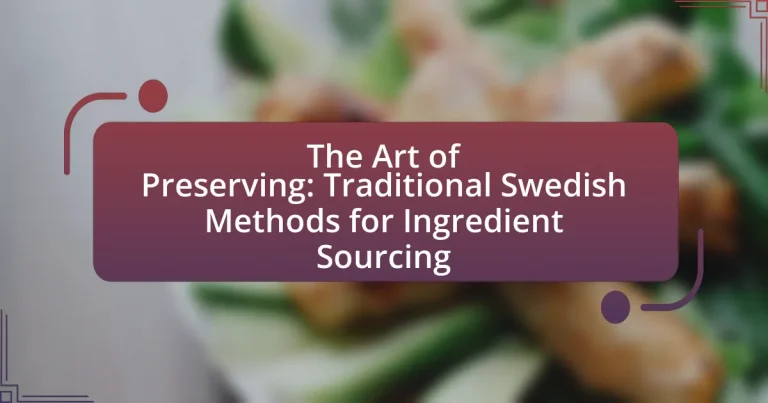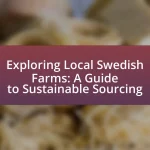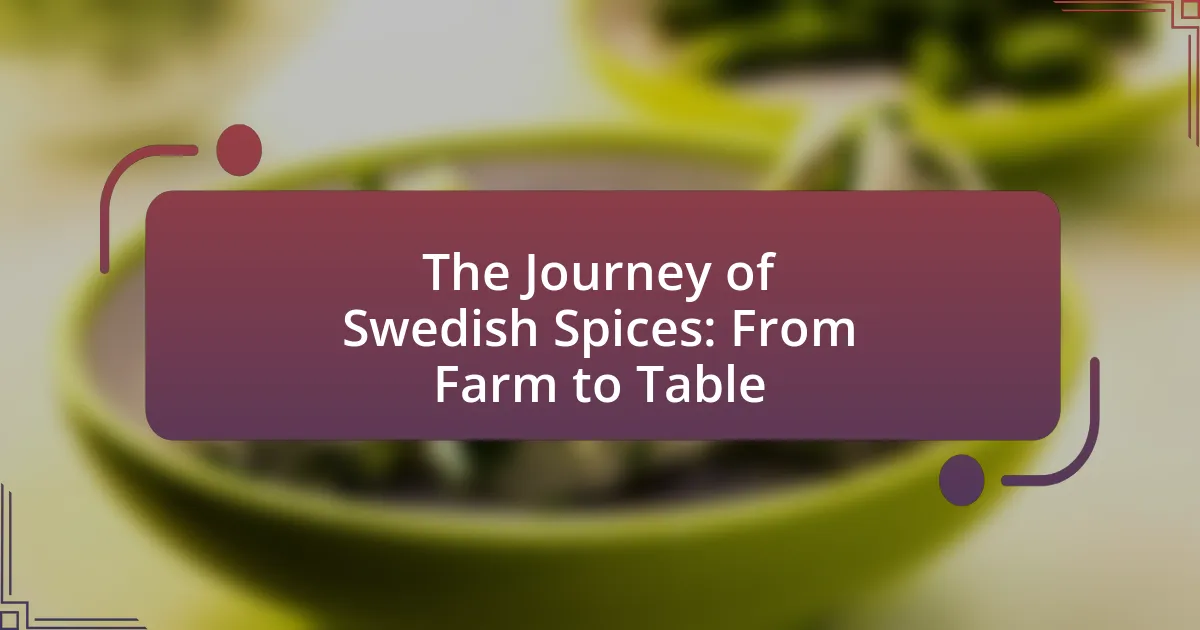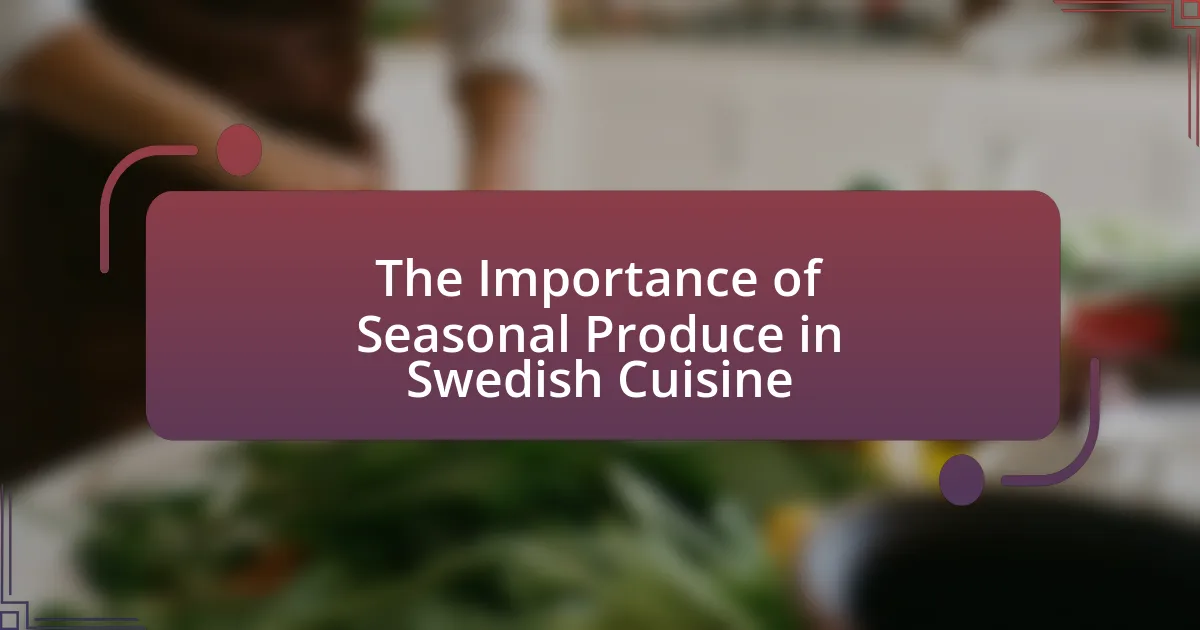The article focuses on traditional Swedish methods for ingredient sourcing, emphasizing practices such as foraging, fishing, and farming that are integral to Sweden’s culinary heritage. It explores how these methods reflect Swedish culture and history, highlighting the influence of historical events like the Viking Age and agricultural reforms on food preservation techniques. The article also examines regional variations in preservation practices, the importance of seasonal and local sourcing, and key preservation techniques such as fermentation, drying, smoking, and pickling. Additionally, it provides practical guidance for implementing these methods at home, including essential tools, safety precautions, and tips for enhancing flavor and quality in preserved foods.

What are Traditional Swedish Methods for Ingredient Sourcing?
Traditional Swedish methods for ingredient sourcing include foraging, fishing, and farming, which have been integral to the country’s culinary heritage. Foraging involves gathering wild herbs, berries, and mushrooms, a practice rooted in Sweden’s natural landscape and seasonal availability. Fishing, particularly in the Baltic Sea and lakes, provides a variety of fish, such as herring and salmon, which are essential to traditional dishes. Farming, especially of root vegetables and grains, has been practiced for centuries, with crops like potatoes and rye forming the basis of many meals. These methods reflect a deep connection to the land and seasonal cycles, ensuring sustainability and freshness in Swedish cuisine.
How do these methods reflect Swedish culture and history?
Traditional Swedish methods for ingredient sourcing, such as foraging, pickling, and fermenting, reflect the culture and history of Sweden by emphasizing sustainability, community, and a deep connection to nature. These practices stem from historical necessity, as rural communities relied on preserving food to survive harsh winters, showcasing a resourceful approach to food security. For example, the tradition of pickling herring dates back to the 16th century, illustrating how these methods have been passed down through generations, reinforcing communal ties and local identity. Additionally, the modern resurgence of these practices aligns with contemporary values of environmental stewardship and local sourcing, further embedding them in Swedish cultural identity.
What historical events influenced the development of these methods?
The development of traditional Swedish methods for ingredient sourcing was significantly influenced by historical events such as the Viking Age, which emphasized preservation techniques for long voyages, and the agricultural reforms of the 18th century that promoted food preservation for winter sustenance. The Viking Age (circa 793-1066) necessitated the use of salting, smoking, and drying to ensure food longevity during expeditions. Additionally, the agricultural reforms led by figures like King Charles XI encouraged the use of fermentation and pickling, which became essential for food storage in the harsh Nordic climate. These events collectively shaped the methods still utilized in Sweden today.
How do traditional practices vary across different regions of Sweden?
Traditional practices in Sweden vary significantly across regions due to differences in climate, geography, and cultural influences. For instance, in northern Sweden, the Sámi people engage in reindeer herding and utilize traditional methods like smoking and drying to preserve meat, reflecting the harsh Arctic environment. In contrast, southern regions, such as Skåne, emphasize agriculture and employ techniques like pickling and fermenting vegetables, influenced by a milder climate and agricultural abundance. These regional variations are rooted in historical practices, with northern communities relying on preservation methods suited for limited resources, while southern areas have developed diverse agricultural traditions that include preserving fruits and grains.
Why is ingredient sourcing important in Swedish preservation techniques?
Ingredient sourcing is crucial in Swedish preservation techniques because it directly impacts the quality and flavor of preserved foods. High-quality, locally sourced ingredients ensure that traditional methods, such as fermentation and pickling, yield optimal results, enhancing the taste and nutritional value of the final products. For instance, the use of fresh, seasonal produce aligns with the Swedish philosophy of utilizing what is available in the environment, which not only supports local agriculture but also maintains the authenticity of traditional recipes. This practice is rooted in Sweden’s culinary heritage, where the emphasis on natural ingredients has been documented in various studies, highlighting the importance of sourcing in achieving the desired preservation outcomes.
What role do seasonal ingredients play in Swedish preservation?
Seasonal ingredients are crucial in Swedish preservation as they dictate the availability and quality of food for preservation methods. In Sweden, traditional practices such as pickling, fermenting, and drying rely heavily on ingredients harvested at their peak ripeness, ensuring optimal flavor and nutritional value. For instance, the summer months yield an abundance of berries and vegetables, which are often preserved for winter use, allowing for a sustainable food supply throughout the year. This reliance on seasonal produce not only enhances the taste of preserved foods but also aligns with Sweden’s cultural emphasis on local and sustainable sourcing, reflecting a deep-rooted connection to the natural cycles of the environment.
How does local sourcing impact the quality of preserved foods?
Local sourcing significantly enhances the quality of preserved foods by ensuring freshness and reducing the time between harvest and processing. When ingredients are sourced locally, they are often picked at peak ripeness, which maximizes flavor and nutritional value. For example, studies show that fruits and vegetables lose nutrients over time, and local sourcing minimizes this loss by shortening transportation distances. Additionally, local sourcing supports sustainable practices, as it often involves smaller-scale farms that prioritize quality over quantity, leading to superior preserved products.

What are the Key Techniques Used in Traditional Swedish Preservation?
The key techniques used in traditional Swedish preservation include fermentation, drying, smoking, and pickling. Fermentation is utilized for preserving vegetables and fish, enhancing flavors while extending shelf life; for example, surströmming is fermented herring. Drying removes moisture from foods like fruits and meats, preventing spoilage; dried lingonberries are a common example. Smoking imparts flavor and preserves fish and meats, with gravlax being a notable dish. Pickling involves immersing foods in vinegar or brine, commonly seen in pickled cucumbers and herring, which are staples in Swedish cuisine. These methods have historical significance, dating back centuries, and are integral to Sweden’s culinary heritage.
How do fermentation and pickling contribute to ingredient preservation?
Fermentation and pickling contribute to ingredient preservation by creating environments that inhibit spoilage microorganisms. Fermentation utilizes beneficial bacteria and yeasts to convert sugars into acids or alcohol, which lowers pH and creates conditions unfavorable for harmful bacteria. For example, lactic acid fermentation in vegetables produces lactic acid, preserving the food while enhancing its flavor and nutritional profile. Pickling, on the other hand, involves immersing ingredients in a solution of vinegar or brine, which also lowers pH and creates a hostile environment for spoilage organisms. Historical practices in Sweden, such as pickling herring in vinegar, demonstrate the effectiveness of these methods in extending shelf life and maintaining food safety.
What are the most common fermented foods in Sweden?
The most common fermented foods in Sweden include surströmming, filmjölk, and knäckebröd. Surströmming is fermented herring, known for its strong odor and unique flavor, traditionally consumed with flatbreads. Filmjölk is a fermented milk product similar to yogurt, often enjoyed with breakfast. Knäckebröd, or crispbread, is sometimes fermented during its preparation, contributing to its distinct texture and flavor. These foods reflect Sweden’s rich culinary heritage and preservation techniques, emphasizing the importance of fermentation in traditional Swedish cuisine.
How does the pickling process differ from other preservation methods?
The pickling process differs from other preservation methods primarily by using an acidic solution, typically vinegar, to inhibit microbial growth and preserve food. Unlike methods such as freezing or drying, which remove moisture to prevent spoilage, pickling relies on the acidity to create an environment unsuitable for bacteria. This method not only preserves the food but also enhances its flavor through fermentation or the addition of spices. Historical evidence shows that pickling has been used for thousands of years, with records dating back to ancient Mesopotamia, highlighting its long-standing effectiveness as a preservation technique.
What role does drying play in Swedish preservation methods?
Drying is a crucial method in Swedish preservation techniques, primarily used to extend the shelf life of various foods. This process reduces moisture content, inhibiting the growth of bacteria, yeast, and molds, which are responsible for spoilage. Historically, drying has been employed for preserving fish, meats, and fruits, with techniques such as air drying and sun drying being common. For instance, the traditional method of drying fish, known as “klippfisk,” involves salting and then air-drying, which can preserve the fish for months. This method not only enhances the flavor but also ensures that food remains safe for consumption during long winters, demonstrating its significance in Swedish culinary practices.
What types of ingredients are typically dried in Sweden?
In Sweden, common ingredients that are typically dried include herbs, berries, and fish. Dried herbs such as dill and thyme are often used in traditional dishes, while berries like lingonberries and cloudberries are dried for preservation and later use in jams or desserts. Additionally, fish, particularly herring, is dried as a method of preservation that dates back centuries, allowing for long-term storage and use in various recipes. This practice is rooted in Sweden’s historical reliance on natural resources and the need for food preservation during long winters.
How does drying affect the flavor and texture of ingredients?
Drying significantly enhances the flavor and alters the texture of ingredients by concentrating their natural sugars and flavors while reducing moisture content. This process intensifies the taste, making dried fruits, for example, sweeter and more flavorful compared to their fresh counterparts. Additionally, drying changes the texture; ingredients become chewier or crispier, depending on the method used. For instance, dried herbs lose their moisture, resulting in a more potent flavor profile and a brittle texture, which is ideal for seasoning. The Maillard reaction, which occurs during drying, also contributes to the development of complex flavors, further validating the impact of drying on both flavor and texture.

How Can One Implement Traditional Swedish Preservation Techniques at Home?
To implement traditional Swedish preservation techniques at home, one can utilize methods such as pickling, fermenting, and drying. Pickling involves submerging vegetables or fish in a vinegar solution, which not only enhances flavor but also extends shelf life; this method is historically significant in Sweden, where herring is commonly pickled. Fermenting, another key technique, can be applied to vegetables like cabbage to create sauerkraut, leveraging beneficial bacteria for preservation and health benefits. Drying fruits and herbs, a practice rooted in Swedish culture, can be achieved by air-drying or using a dehydrator, effectively concentrating flavors while preventing spoilage. These methods are validated by Sweden’s long-standing culinary traditions, which emphasize seasonal ingredient use and preservation for year-round consumption.
What are the essential tools and ingredients needed for home preservation?
The essential tools and ingredients needed for home preservation include canning jars, lids, a water bath canner, a pressure canner, and basic ingredients such as fruits, vegetables, sugar, vinegar, and salt. Canning jars and lids are crucial for sealing preserved items, while a water bath canner is used for high-acid foods, and a pressure canner is necessary for low-acid foods to ensure safety. Fruits and vegetables serve as the primary ingredients, with sugar, vinegar, and salt acting as preservatives that enhance flavor and extend shelf life. These tools and ingredients are foundational for effective home preservation, ensuring food safety and quality.
How can beginners start with simple preservation techniques?
Beginners can start with simple preservation techniques by learning basic methods such as pickling, drying, and freezing. Pickling involves immersing vegetables in a vinegar solution, which creates an acidic environment that inhibits bacterial growth, thus preserving the food. Drying removes moisture from fruits and herbs, preventing spoilage, while freezing halts the growth of microorganisms by lowering the temperature. These methods are accessible and require minimal equipment, making them ideal for novices. Historical practices in Sweden, such as fermenting herring and drying berries, demonstrate the effectiveness of these techniques in extending the shelf life of ingredients.
What safety precautions should be taken during the preservation process?
During the preservation process, it is essential to maintain cleanliness and proper sanitation to prevent contamination. This includes washing hands, using clean utensils, and ensuring that all surfaces are sanitized. Additionally, it is crucial to monitor temperatures to inhibit bacterial growth, as food should be kept at safe temperatures during preparation and storage. The USDA recommends keeping perishable foods below 40°F (4°C) and cooking foods to appropriate internal temperatures to ensure safety. Proper labeling and storage of preserved items also help in avoiding spoilage and ensuring that the food remains safe for consumption.
What tips can enhance the effectiveness of traditional preservation methods?
To enhance the effectiveness of traditional preservation methods, it is essential to maintain optimal temperature and humidity levels during the preservation process. Proper temperature control prevents spoilage and microbial growth, while appropriate humidity levels ensure that ingredients do not dry out excessively or become too moist, which can lead to mold. For instance, studies show that maintaining a temperature below 4°C significantly slows down the growth of bacteria in preserved foods. Additionally, using high-quality, fresh ingredients improves the overall preservation outcome, as the initial quality directly impacts the longevity and flavor of the preserved product.
How can one ensure the best flavor and quality in preserved foods?
To ensure the best flavor and quality in preserved foods, one should select fresh, high-quality ingredients and use proper preservation techniques. Fresh ingredients contain optimal flavor compounds and nutrients, which are crucial for maintaining the quality of the final product. Techniques such as canning, fermenting, or drying should be executed with precision, following established guidelines to prevent spoilage and retain taste. For example, using the right acidity levels in canning can inhibit bacterial growth, ensuring safety and flavor integrity. Additionally, storing preserved foods in cool, dark places can further enhance their longevity and taste.
What common mistakes should be avoided in the preservation process?
Common mistakes to avoid in the preservation process include improper temperature control, inadequate sterilization, and using unsuitable containers. Improper temperature control can lead to spoilage, as many preservation methods rely on specific temperature ranges to inhibit microbial growth. Inadequate sterilization can result in contamination, compromising the safety and quality of preserved items. Using unsuitable containers, such as non-food-grade materials, can leach harmful substances into the preserved food, affecting both safety and flavor. These mistakes can significantly diminish the effectiveness of traditional preservation methods, such as those used in Swedish ingredient sourcing.





